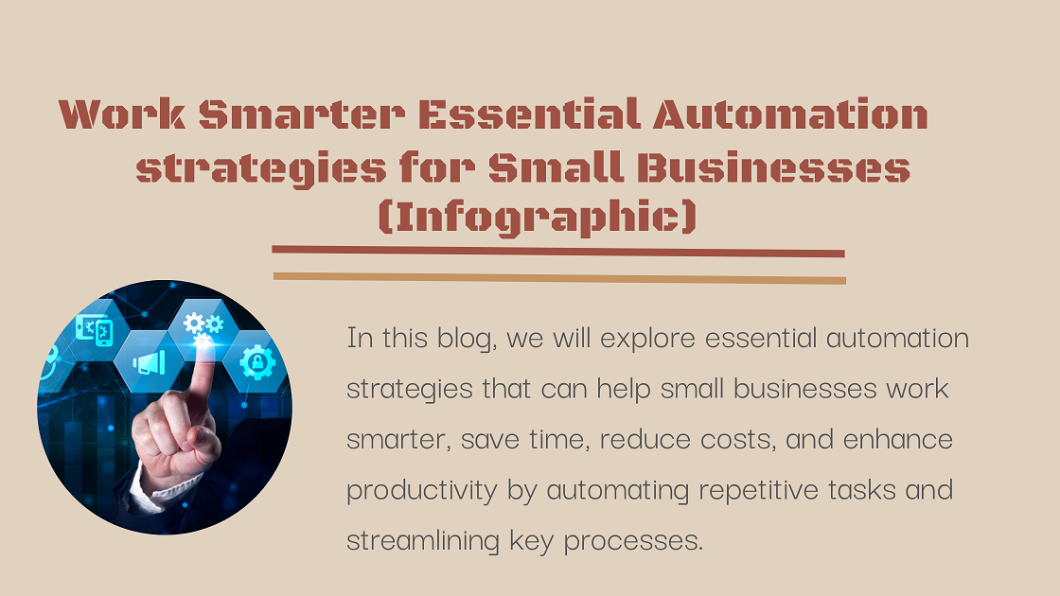
In today’s fast-paced business landscape, small businesses are expected to deliver big results—often with limited time, staff, and resources. This is where automation steps in. In simple terms, automation involves using technology to perform tasks that would otherwise require manual effort. For small businesses, this can range from automating emails and social media posts to streamlining customer service and accounting.
The mantra “work smarter, not harder” has never been more relevant. By embracing automation, small businesses can save valuable time, reduce human error, cut costs, and improve scalability. Whether you’re a solopreneur or managing a growing team, the right automation strategies can transform how you operate and help you focus on what truly matters—growing your business.
1. Why Automation is a Game-Changer for Small Businesses
Small businesses typically operate with limited staff, time, and capital. This makes efficiency not just a bonus, but a necessity. Automation helps bridge the gap by taking over repetitive and time-consuming tasks, allowing teams to focus on high-impact activities like strategy, customer engagement, and innovation.
In a digital-first world, staying competitive means keeping up with customer expectations—quick responses, seamless experiences, and personalized communication. Automation helps small businesses deliver all of that without burning out their team.
Real-world example:
A fitness coach using automated email sequences to send personalized workout tips and reminders can increase client engagement and retention—without having to manually follow up with each individual. Similarly, a restaurant that automates reservation confirmations and payment reminders can streamline operations and improve customer satisfaction.
2. Core Areas to Automate in Your Small Business
a. Customer Relationship Management (CRM)
CRM tools help you manage customer data, interactions, and sales pipelines more effectively.
Recommended tools: HubSpot, Zoho CRM, Pipedrive
Key automations:
- Automatic follow-up emails after customer interactions
- Lead nurturing workflows
- Segmented email campaigns based on behavior or preferences
b. Marketing Automation
Marketing is essential but time-consuming. Automation helps you maintain a consistent presence without constant manual input.
Use cases:
- Email marketing: Automate welcome sequences, abandoned cart reminders, and post-purchase follow-ups using platforms like Mailchimp or ActiveCampaign
- Social media scheduling: Tools like Buffer and Later allow you to schedule posts in advance across multiple platforms
- Ad campaigns: Use rules and triggers to pause underperforming ads or increase budget on high performers
c. Sales and E-commerce Processes
Automation can streamline the entire sales process, improving both speed and customer satisfaction.
Automated tasks:
- Invoicing and receipts
- Order confirmation emails
- Real-time order tracking updates
Integrations to consider:
- Payment platforms like Stripe or PayPal
- E-commerce platforms like Shopify or WooCommerce
You can also set up systems for upselling and cross-selling, triggered by customer behavior or past purchases.
d. Operations and Workflow Management
Internal operations can benefit greatly from automation, especially when it comes to collaboration and task tracking.
Tools to try: Trello, Asana, ClickUp
Automation examples:
- Assigning tasks based on project templates
- Triggering workflows when a new project begins
- Automatically updating inventory levels when a sale is made
This helps reduce bottlenecks and ensures everyone stays on the same page.
e. Customer Service
Providing fast, helpful support is key—but that doesn’t mean you need to be online 24/7.
Automation tools: Tidio, Intercom, Freshdesk
Functions to automate:
- Answering FAQs via chatbots
- Creating support tickets from inquiries
- Routing messages to the right team member
These tools improve customer experience while freeing your team for more complex support issues.
f. Finance and Accounting
Finances are the backbone of your business. Automating financial processes can reduce stress and errors.
Popular tools: QuickBooks, Xero, Wave
Automation ideas:
- Automatically categorize transactions
- Generate monthly reports
- Send recurring invoices
- Run payroll with minimal manual input
By automating bookkeeping and expense tracking, you’ll always have a clear picture of your financial health.
Final Thoughts
The key to small business success isn’t doing more—it’s doing smarter. Automation helps you reclaim your time, operate more efficiently, and compete with larger players. Start by identifying the most repetitive tasks in your business and explore tools that can handle them automatically. Begin small, track your results, and scale gradually. Before long, you’ll be working less on the grind—and more on growth.
If you’d like help implementing any of these automation strategies for your business, feel free to contact me and let’s get started!

